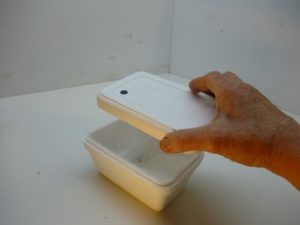Hi Margriet – when is your best guess as to when to put out the Bee Cocoons? I have had them in my outside storage shed all winter, but with the warmer weather as of late, and not much in the way of flowering trees, etc., I hate to have the Bees emerge too early, so I have placed them in a picnic cooler with ice packs, to simulate a cooler or colder climate. Let me know what you suggest. Thanks, Andy.

Mason Bee cocoon humidity cooler. Cocoons on one side and a moist pad on the other side of the divide. Lid with 2 holes allows for air circulation and containment of humidity. Fridge temperature 2-4C.
Hi Andy, Yes the cooler will work in the short term. For the longer term, use a humidity cooler inside a fridge. A storage shed works until it warms up in late winter. The simplest way of storing bees is in the attic of a bee home. Bees will emerge when temperatures improve during the early spring. But with experience, if you find that bees emerge earlier than fruit tree blossoms in your garden, then refrigeration inside a humidity cooler is the way to go. Temperature inside the fridge needs to be between 2-4C. If mason bees are kept in hibernation until late April- early May, fridge temperature needs to be decreased to 1-2C. Dr Margriet.
Go to Humidity Cooler at Beediverse

Al Charlesworth
Hi Margreit, my wife and I are new to this Mason Bee raising, we placed our two boxes of cocoons in a blue berry container on a lid and placed a wet paper towel next to the boxes, when we checked them last night one of the boxes had some how got wet and three bees had emerged from their cocoons. The blue berry container did have its lid on it, but I read that the container should be air tight. Because three males had emerged we panic and placed cocoons and emerged males in the bee house. We live in Airdrie ab and this happened Wednesday night May 9th 2018.
margriet dogterom
Hello Al- let nature do its thing. If some of the cocoons were wet- they will dry dry and warm up during the day. I bet some of the others have now emerged. Sorry for my slow response to your comment. Hope this helps
margriet
Liz Marion
Hi Margriet, I have natural mason bees living in the back of my building at work. We have planted a garden there and thankfully the bees came. it is an industrial building with aluminum siding with holes in it where screws should go, but there are about 20 holes with no screws. We had plenty of bees all year so far, now I do not see too many. It was very very hot last week and the area faces full south exposure. I do leave a bowl of water filled with rocks in it for them to drink from. Is this the time of year they rest? Do you think the heat has sent them away? Is there anything I can do for them? Thank you so much.
Ray Corse
It seems to me , that if mason bees are “native” they can and will survive the harshest of winters. If so, then why do most of the sites talk about taking the cacoons inside and keeping in the frig.? Would they not survive on their own in the nesting tubes outside?
Andrew Frizzell
Ray of course this is true under perfect conditions. Regretfully what we have now are not perfect conditions. We have warmer winters where the temperatures rise to the point of the bees developing and at times emerging, then the temp suddenly drops killing the bees. Some would survive on their own but many would not, we have seen dramatic decline in our natural pollinators. Caring for the bees by taking them inside is a way to help repopulate native bees and ensure a healthy survival rate.